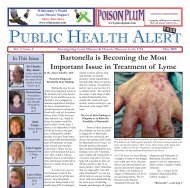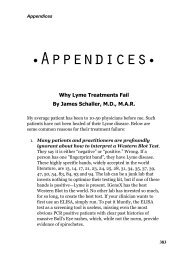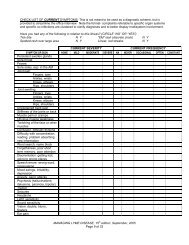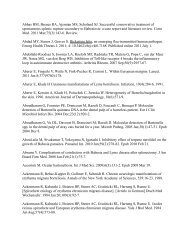Download Here - James L. Schaller, M.D., M.A.R., P.C
Download Here - James L. Schaller, M.D., M.A.R., P.C
Download Here - James L. Schaller, M.D., M.A.R., P.C
Create successful ePaper yourself
Turn your PDF publications into a flip-book with our unique Google optimized e-Paper software.
Environmentally Friendly Mold Remediation Techniques That Significantly Reduce Childhood Asthmaother words, deciding what indicators or measurable results will beconsidered evidence of an acceptable outcome or job “clearance.”Setting clearance levels too low will impracticably increase costswithout additional practical benefit. Instead, the criteria should beselected to show, in combination with other evidence and informationabout the remediation activities, that both the remediated area wasacceptably clean and dry at the time when the job was finished andthat conditions that allowed mold growth were corrected. Whenusing numerical criteria for clearance, it may be necessary to set testmethod-specific criteria for interpreting testing results. This must bedetermined before the remediation work begins and should ideally beunderstood and accepted by all key stakeholders.The usual issue that comes up in determining remediation goals iswhether the goal of remediation is to bring the location back to prelosscondition or to a pristine / "like-new" condition.This can be an important distinction if the location was originallyrather dusty or dirty. Dust and dirt always contain settled moldspores and the toxins and allergens that always accompany them.Once an occupant is exposed to mold they may become sensitized andreturning the contaminated space to pre-loss condition may not beacceptable to provide a healthful environment for (now) moldsensitive occupants. The remediation goal may need to be to bring theenvironment to pristine or "like-new" condition.10.2.1 Evaluation of Remediation MethodsThe project manager should confirm that the previously determinedremediation plan is being followed or needs to be updated. Thisshould be confirmed by periodic inspections and a closeout documentthat should be included in the final report.The following are examples of some common problems that may beidentified by the project manager.• incorrect mixing of chemicals;• overloaded HEPA filters in vacuum cleaners and negative airmachines, that no longer draw enough air;92











